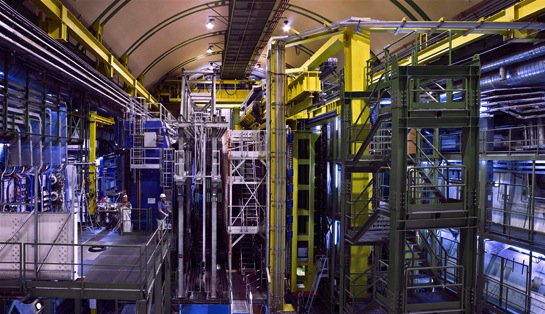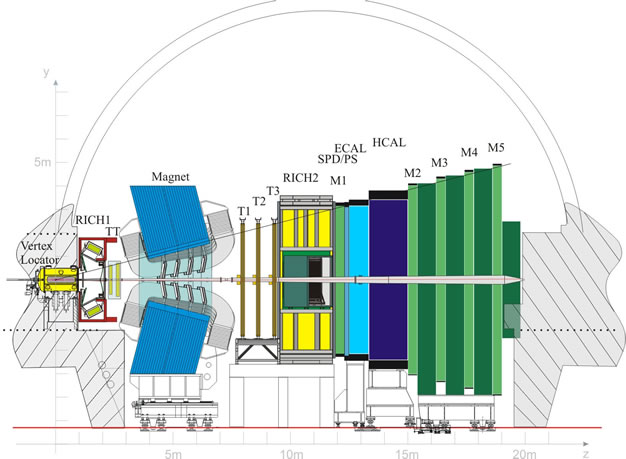LHCb: a different type of detector
A blog post from Quantum Diaries by Anna Phan, published on Sunday, April 10th, 2011
Greetings and salutations everybody! I’m gratified and honoured to be the first LHCb US LHC blogger. As well being new to US LHC, I’m also new to the LHCb collaboration, so we can all learn about LHCb and B physics together.
Today I thought I would start by introducing the LHCb detector. Here is a schematic:
If you are familiar with the two largest LHC experiments, ATLAS or CMS, this may look a little different to you. LHCb is not a general purpose detector, with the aim of detecting as many different types of physics events as possible; it is especially designed to measure the decays of (B) mesons (more about why we care specifically about (B) mesons in a future post).
ATLAS and CMS are essentially cylindrical in shape, while LHCb is a cone, taking advantage of the strongly forward peaked probability distribution of (B) meson production. This means that while the detector only covers around 4% solid angle, it is able to measure around 40% of (B) meson production.
The decay products of (B) mesons are identified and measured by different detector components:
- Closest to the proton-proton interaction region is the vertex detector, known as the VELO. Its job is to measure the particle tracks to precisely separate primary and secondary vertices. This is important to identify (B) mesons and their decay products. For example, in the image below, we have been able to identify three vertices: PV, SV and TV, and associate them with particular events: PV – the production of an (B_s) meson, SV – the decay of the (B_s) meson into a muon and a (D_s) meson, and TV – the decay of the (D_s) meson into a (K) and two (pi) mesons. These three vertices could not have been identified without the VELO.

- There are two ring imaging Cherenkov detectors, known as RICH1 and RICH2, which are used for particle identification. For example, they can differentiate between the (K) and the (pi) mesons in the decay chain described above.
- Reconstruction of charged particle tracks and momentum measurement is performed by the tracking system, made up of the TT, T1, T2 and T3 stations in the schematic.
- Following these are the electromagnetic and hadronic calorimeters (ECAL and HCAL), which measure the energy of electrons, photons and hadrons.
- Finally, there are there is the muon system (M1, M2, M3, M4 and M5), which identifies and measures muons.
Along with these detector components, there is a dipole magnet to help measure particle momenta. Particles normally travel in straight lines, but in a magnetic field the paths of charged particles curve, with positive and negative particles moving in opposite directions. By examining the curvature of the path, it is possible to calculate the momentum of a particle.
There you have it, a brief overview of the LHCb detector and its components. This is what it looks like in reality:

Note that I’ve flipped the photo horizontally so it is easier to match the detector components in the schematic to their real counterparts.
< PREV | NEXT >

